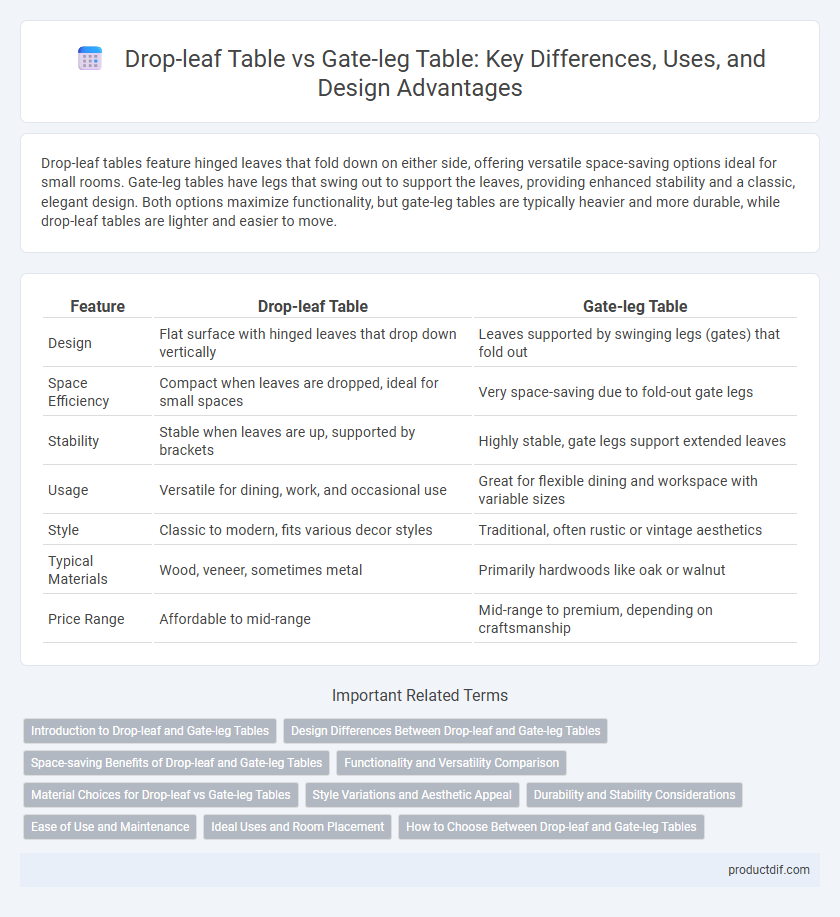Drop-leaf tables feature hinged leaves that fold down on either side, offering versatile space-saving options ideal for small rooms. Gate-leg tables have legs that swing out to support the leaves, providing enhanced stability and a classic, elegant design. Both options maximize functionality, but gate-leg tables are typically heavier and more durable, while drop-leaf tables are lighter and easier to move.
Table of Comparison
| Feature | Drop-leaf Table | Gate-leg Table |
|---|---|---|
| Design | Flat surface with hinged leaves that drop down vertically | Leaves supported by swinging legs (gates) that fold out |
| Space Efficiency | Compact when leaves are dropped, ideal for small spaces | Very space-saving due to fold-out gate legs |
| Stability | Stable when leaves are up, supported by brackets | Highly stable, gate legs support extended leaves |
| Usage | Versatile for dining, work, and occasional use | Great for flexible dining and workspace with variable sizes |
| Style | Classic to modern, fits various decor styles | Traditional, often rustic or vintage aesthetics |
| Typical Materials | Wood, veneer, sometimes metal | Primarily hardwoods like oak or walnut |
| Price Range | Affordable to mid-range | Mid-range to premium, depending on craftsmanship |
Introduction to Drop-leaf and Gate-leg Tables
Drop-leaf tables feature hinged sections, or "leaves," that fold down on either side to save space while providing a larger surface when extended. Gate-leg tables incorporate legs that swing open like gates to support the drop leaves, offering increased stability and a distinctive design. Both table types maximize functionality in compact areas by combining space-saving mechanisms with versatile surface expansion.
Design Differences Between Drop-leaf and Gate-leg Tables
Drop-leaf tables feature hinged leaves on one or both sides that fold down to save space, characterized by simple leg supports beneath each leaf. Gate-leg tables have hinged leaves supported by swinging legs, called gate legs, that pivot outwards to hold the extended tabletop securely. The key design difference lies in the leg mechanism: drop-leaf tables rely on fixed legs while gate-leg tables use movable legs for additional stability.
Space-saving Benefits of Drop-leaf and Gate-leg Tables
Drop-leaf tables feature hinged sections that fold down to minimize floor space, making them ideal for small rooms or apartments. Gate-leg tables have swinging legs that fold out to support extended surfaces, offering flexible dining or workspace options without permanent bulk. Both designs maximize space efficiency by enabling easy expansion or contraction based on usage needs.
Functionality and Versatility Comparison
Drop-leaf tables feature hinged sections that fold down to save space and easily expand the surface area, making them ideal for small rooms and flexible dining arrangements. Gate-leg tables incorporate swinging legs that support the drop leaves when extended, providing enhanced stability and a classic design suited for both dining and workspace purposes. The choice between the two depends on desired mobility, load capacity, and the frequency of table adjustments in multifunctional living areas.
Material Choices for Drop-leaf vs Gate-leg Tables
Drop-leaf tables often feature hardwoods like oak, maple, or cherry for durability and a smooth folding mechanism, while gate-leg tables commonly use sturdy woods such as walnut or mahogany to support heavier legs that swing out. Veneers and engineered wood options are popular in drop-leaf designs to reduce costs without sacrificing style, whereas gate-leg tables tend to favor solid wood construction for stability. Finishes including lacquer, varnish, and oil enhance the wood's natural grain and protect against wear on both table types, tailored to the mechanical stresses of their respective leg and leaf designs.
Style Variations and Aesthetic Appeal
Drop-leaf tables feature hinged leaves that fold down for a compact footprint, offering a classic and versatile style ideal for traditional or rustic interiors. Gate-leg tables have swinging legs that fold out to support the leaves, providing a more intricate design often associated with antique or vintage aesthetics. Both styles maximize space efficiency while contributing distinct visual character--drop-leaf tables emphasize simplicity and function, whereas gate-leg tables highlight craftsmanship and ornate detailing.
Durability and Stability Considerations
Drop-leaf tables feature hinged leaves supported by brackets or legs that fold down, offering moderate stability but potential wear on hinges over time. Gate-leg tables use swinging legs that pivot to support the extended leaf, providing enhanced durability and greater stability due to their solid leg structure. For long-term use in high-traffic areas, gate-leg tables typically outperform drop-leaf tables in resisting wobble and structural fatigue.
Ease of Use and Maintenance
Drop-leaf tables feature hinged sections that easily fold down, making them highly convenient for quick space adjustments and straightforward cleaning. Gate-leg tables have swinging legs that unfold to support extended leaves, offering sturdy support but requiring more effort to set up and maintain. Both tables demand regular dusting and occasional tightening of joints, but drop-leaf models generally provide simpler operation and lower maintenance complexity.
Ideal Uses and Room Placement
Drop-leaf tables are ideal for small spaces, offering flexible surface area that expands when needed and fits compactly against walls in dining rooms or kitchens. Gate-leg tables provide a more stable extended surface, suitable for living rooms or multipurpose spaces where occasional larger gatherings occur. Both optimize room placement by maximizing floor space and adapting to varying functional needs.
How to Choose Between Drop-leaf and Gate-leg Tables
Choosing between drop-leaf and gate-leg tables depends on your space and functionality needs; drop-leaf tables offer straightforward hinged sides for easy expansion, ideal for smaller areas requiring occasional extra surface. Gate-leg tables feature additional legs that swing out to support the leaves, providing enhanced stability for heavier use or larger gatherings. Assess your room layout, frequency of use, and storage requirements to determine which design best balances convenience and durability.
Drop-leaf Table vs Gate-leg Table Infographic

 productdif.com
productdif.com